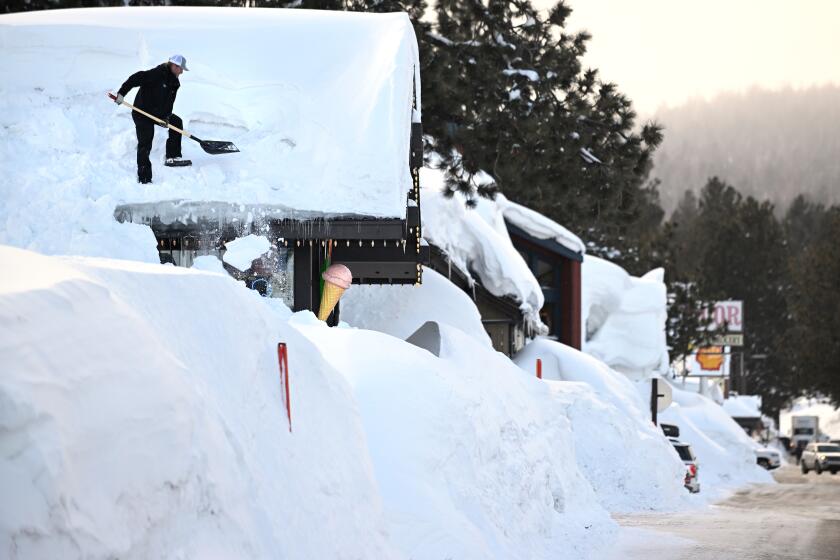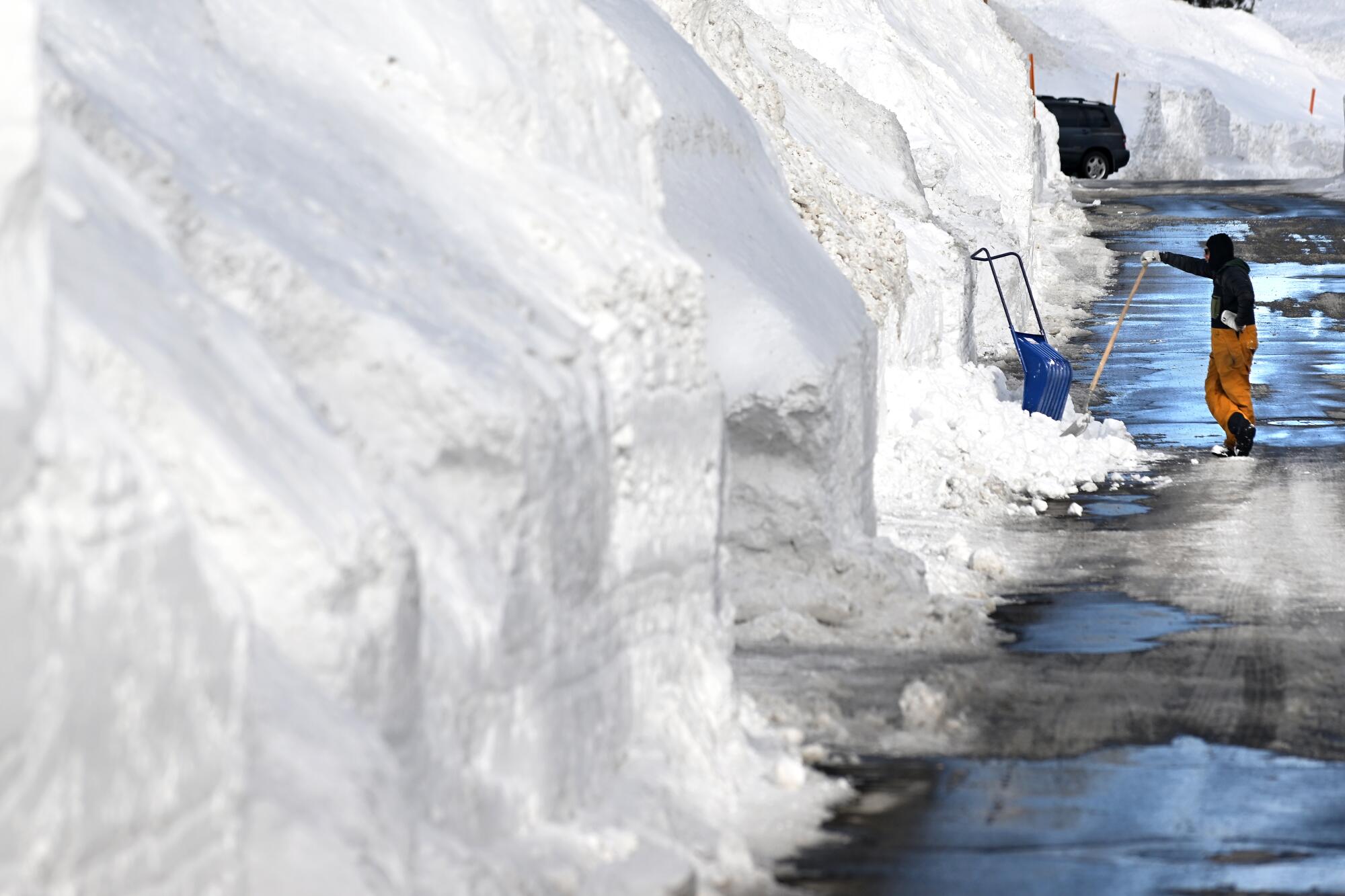
MAMMOTH LAKES, Calif. — Snow began falling early and hard this season at the Mammoth Mountain ski resort, and the record-breaking amounts don’t look like they’ll stop anytime soon.
While ski operators in the eastern Sierra Nevada are hoping the buildup of snow will allow them to stay open as late as July 4, the storms have added a dangerous edge to life in nearby towns as residents confront impenetrable snowbanks, high winds, road closures, avalanches and flooding.
In a worst-case scenario, massive snowmelt in the coming weeks could inundate towns along U.S. Highway 395, which winds along the base of snow-clad Sierra peaks that reach up to 14,000 feet. At the same time, officials with the Los Angeles Department of Water and Power are worried that record runoff in Mono and Inyo counties could overwhelm the city’s network of aqueducts.
“Getting significant rain on top of snow is a scary proposition,” Inyo County Supervisor Jeff Griffiths said Friday, when the first of several anticipated atmospheric rivers swept across the region, triggering warnings of avalanches and wind gusts of 120 mph. “We have at least two more storms coming in over the next 10 days, so the big concern is all the precipitation on the mountains coming down all at once.”
As of this week, Mammoth Mountain — the massive extinct volcano that catches freshly brewed storms like a sail — had recorded a stunning 672 inches of snow at the summit and 528 inches at the main lodge of its resort complex, which attracts a million skiers each year.
“This is already one of our biggest snow years ever — and we still have many more months to go,” said Lauren Burke, a spokeswoman for the resort about 300 miles north of Los Angeles. “We expect to get another 100 inches of snow within 10 days, which could put us above our all-time record of 668 inches — that’s about 55½ feet — at the main lodge.”
With the eastern Sierra Nevada saddled with 243% of its normal snowpack for this time of year, the DWP was scrambling to steer anticipated snowmelt from its century-old water infrastructure in Inyo County’s Owens Valley, about 60 miles south of Mammoth Lakes.
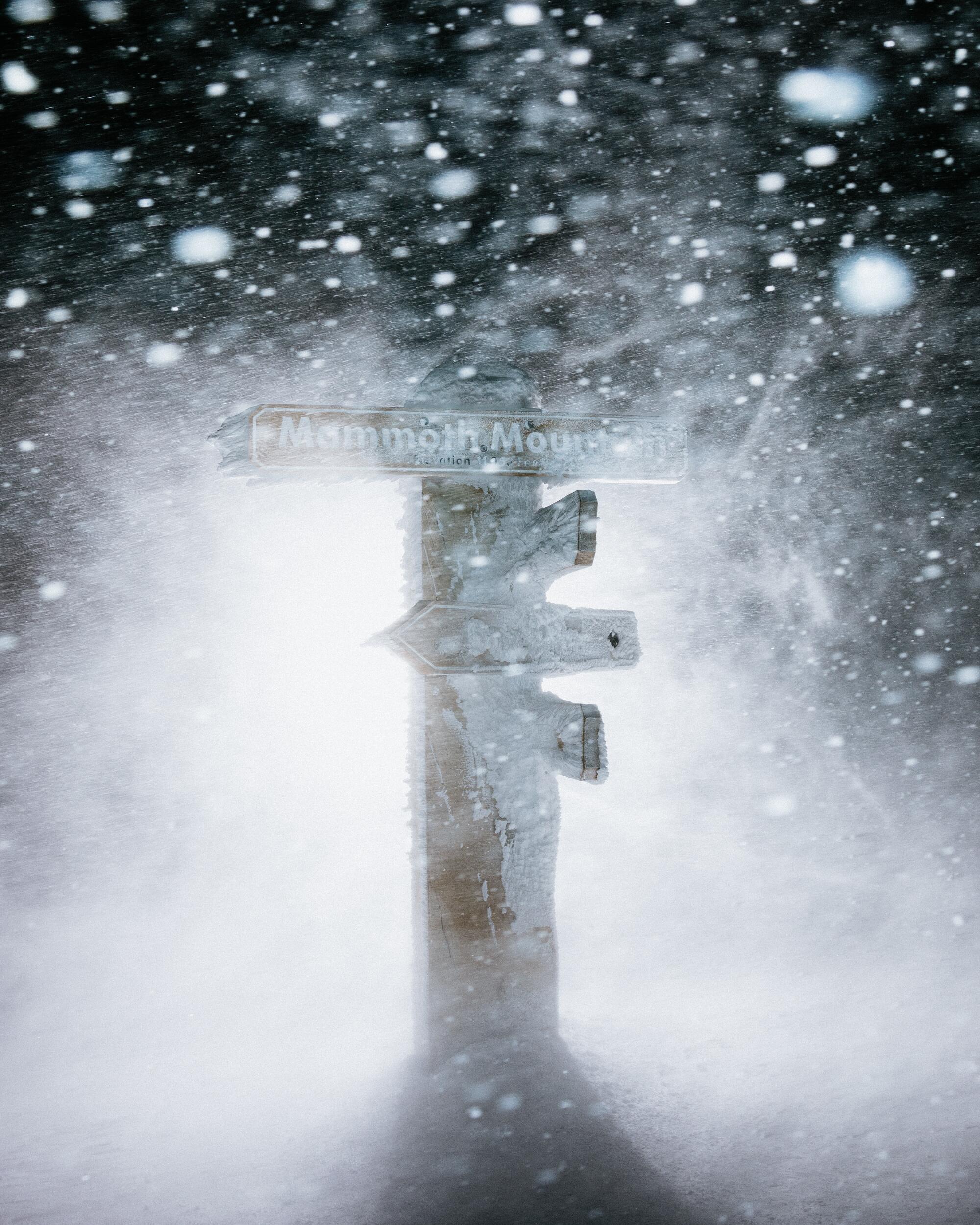
“Only two out of the last 100 years have experienced higher runoff than this year’s estimate,” said Anselmo Collins, senior assistant general manager of the water system. “Right now, DWP crews are mainly focusing on maintaining capacity within the system by cleaning sand traps, canals and other waterways and getting areas ready for the anticipated water flows.”
Meanwhile, in Mammoth Lakes, a scenic town of 7,500 people in Mono County, residents are struggling to adapt to what has become an eerie world of frozen precipitation piled as high as rooftops.
Residents of Mammoth Mountain focus on digging themselves out and bracing for whatever comes next.
Street names have been hand-painted on walls of snow where signposts are no longer visible. Property owners clad in heavy coats and rubber boots endure the ear-splitting roar of snowblowers between banks 20 feet high that test the limits of the equipment. Underfoot, the snow has turned to ice thick enough to skate on.
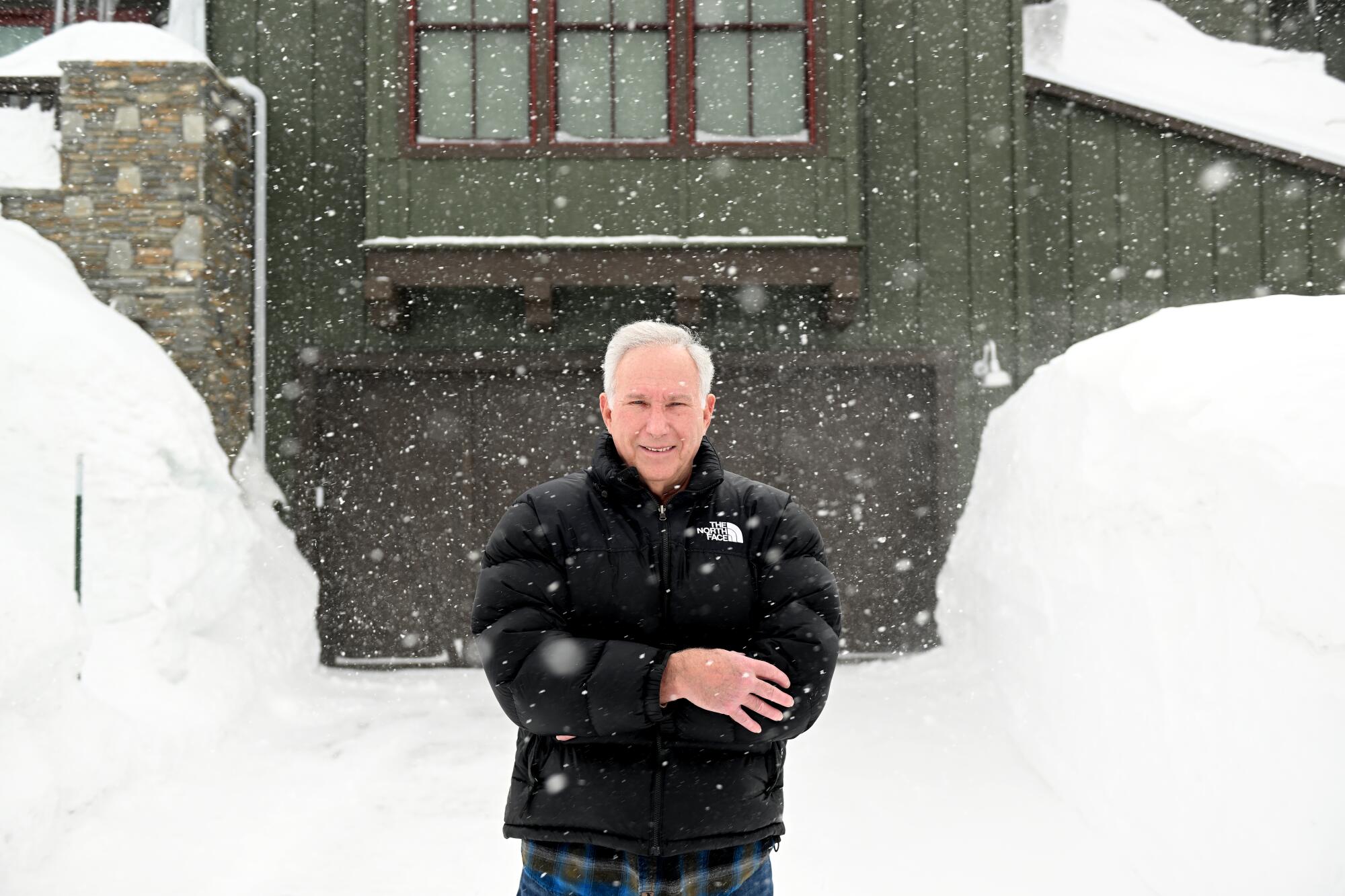
“This is the roughest winter I’ve been through since I moved here in 1978,” said Howard Scheckter, a real estate broker who doubles as the region’s weather sage, posting daily forecasts on his Mammoth Weather website. “The problem is that snow continues to stack up, because this has been an unusually cold winter with very little runoff.”
Nodding glumly toward 15-foot walls of snow on each side of the narrow lane he lives on, Scheckter said, “This is a dangerous situation, and there will be impacts, including structural damage to homes and businesses buried under deeper and deeper layers of heavy snow.”
A three-day storm a week ago triggered power outages in communities north of Bridgeport, about 50 miles to the north of Mammoth Lakes, after several large avalanches buried a half-mile stretch of Highway 395 above Mono Lake and north of Lee Vining, a gateway in warmer months to Yosemite National Park. The park, much of which is buried in record snow, has been closed since Feb. 25.
Separately, Gov. Gavin Newsom issued an emergency declaration in Inyo County allowing the DWP and other agencies to take steps necessary to protect the Los Angeles Aqueduct from destructive floodwaters rushing off the High Sierra.
As it did in 2017, when record-breaking rainfall ended a five-year drought in the region, the DWP plans to reinforce ditches and stream banks with rocks and boulders and to bulldoze new berms to protect the lattice of plumbing and acres of gravel beds it built as part of its $2.5-billion dust-control project on Owens Lake, which L.A. drained to slake its thirst.
The DWP is already spreading snowmelt cascading down the slopes in areas of Owens Valley.
“We began preparing our spreading grounds in December,” Collins said, “based on lessons learned from the extremely high runoff experienced in 2017.”
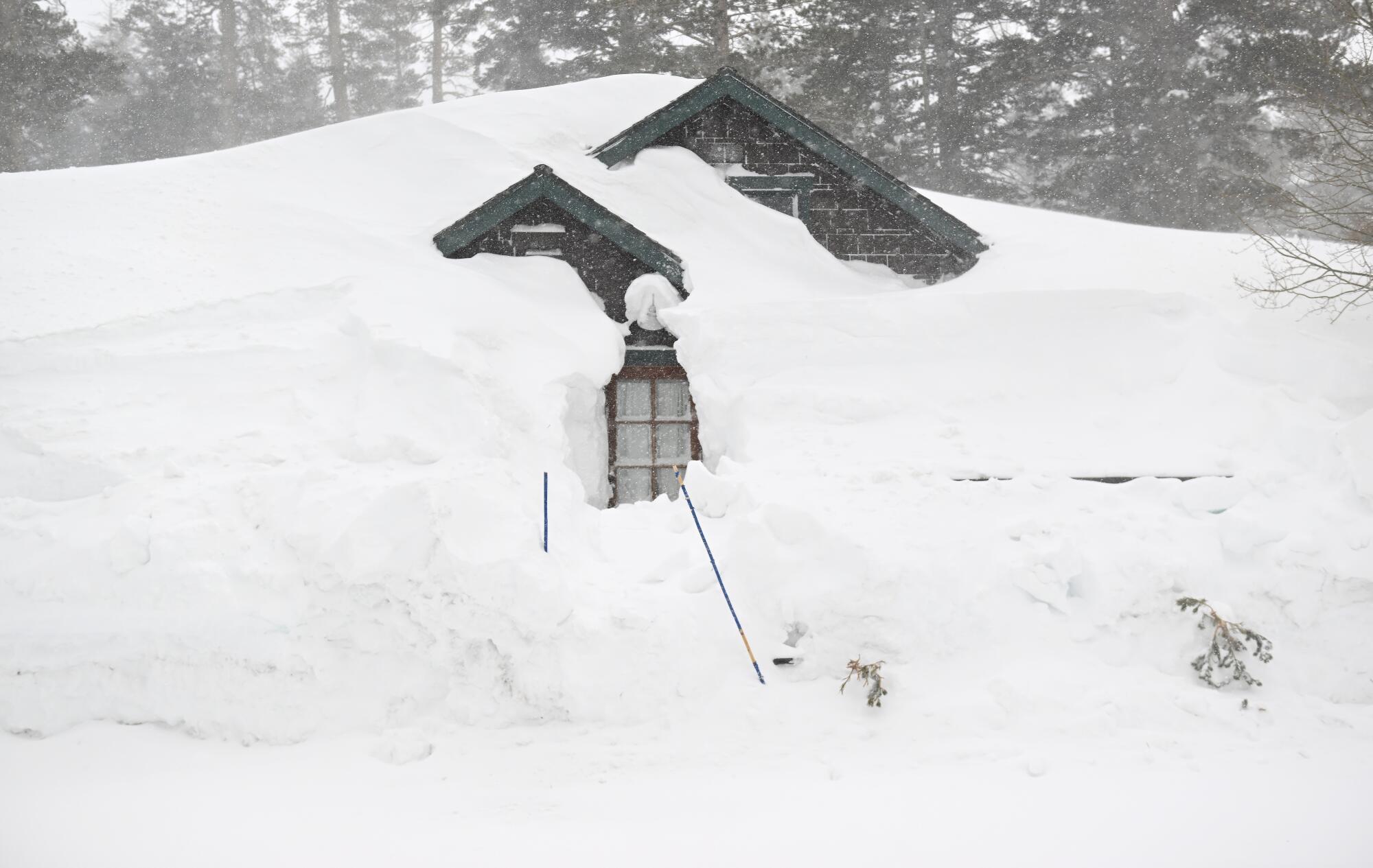
On Friday, rain drummed down on the Long and Owens valleys, dumping floodwater into normally dry ditches and arroyos and hurling mud and debris across key transportation routes, including Highway 395, portions of which were temporarily closed throughout the day.
Avalanche and evacuation warnings were issued for the unincorporated mountain community of Aspendell and the Fort Independence Indian Community of Paiute Indians, which operates a casino and commercial complex north of Independence.
“The important message we’re trying to get out to the public today is harsh: Travel is strongly discouraged this weekend,” said Carma Roper, spokeswoman for the Inyo County Sheriff’s Department. “There is a high likelihood that you won’t make it to your destination due to highway closures from heavy snow and/or flooding. Do not plan on using this weekend to take your family on vacation or recreate outside.”
Amid warnings of even more severe flooding to come when the weather starts to warm up, Inyo County officials, emergency responders and leaders of the region’s seven Paiute tribes have been making evacuation plans.
“In the event of a disaster, our people would be moved 15 miles north to the Bishop Paiute Tribe reservation near Bishop,” said L’eaux Stewart, chairwoman of the Big Pine Paiute Tribe, whose 400 members reside on a floodplain.
“Right now, all our creeks and streams are raging,” she added. “So a primary concern is rounding up sandbags to hold the water back and cleaning out old canals and water diversions.”
The eastern Sierra region has a history of destructive flooding.
In 1982, Main Street in Mammoth Lakes was submerged beneath 2 feet of water. Businesses closed, and the roofs of five mobile homes collapsed under the weight of rain and snow.
In 1989, cloudbursts driven by 60-mph winds gouged out the dirt that fortified a 1,000-foot section of an aqueduct near the community of Cartago and closed a 63-mile stretch of Highway 395. The heavy rains also buried two miles of a ditch under an estimated 100,000 cubic yards of debris.
In 2008, a massive debris flow along the south fork of Oak Creek just north of Independence destroyed 25 houses and wiped out the entire stock of one of California’s oldest fish hatcheries.
Five years later, mud and debris triggered by unusually heavy rains and flash-flooding were blamed for the sudden mass death of fish and other aquatic life along a portion of the Lower Owens River south of Lone Pine.
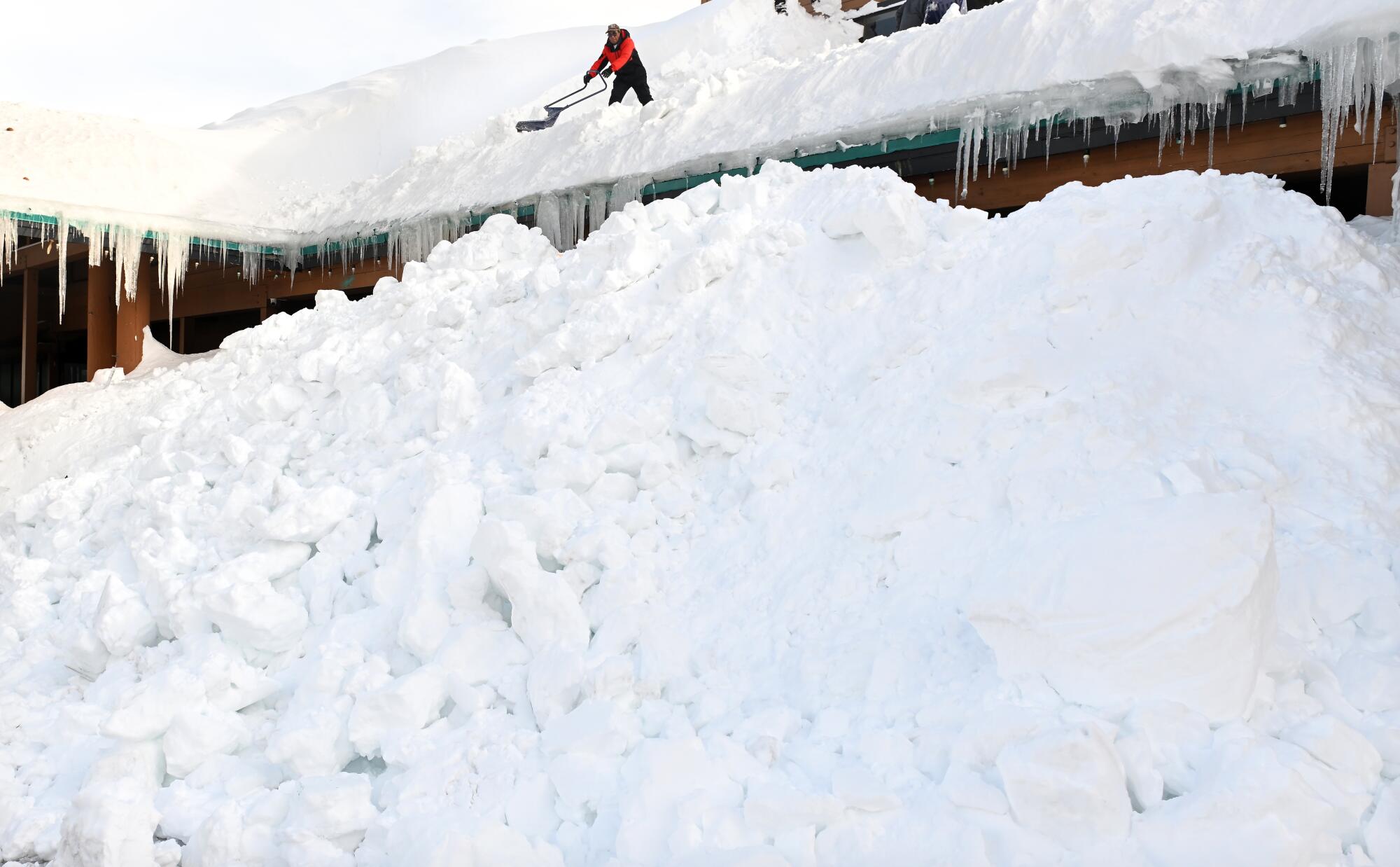
The eastern Sierra’s current predicament holds a certain meteorological irony. Only six months ago, drought-stricken residents and business owners in Mammoth Lakes — sometimes referred to as Los Angeles’ farthest suburb — would have been relieved to know March forecasts would call for rain and snow.
“It’s been snowing here every few days since November, and folks are getting tired of it,” said Steve Johnson, 69, an independent contractor who has lived in Mammoth since 1972. “We can’t travel anywhere we might need to, and it’s making daily routines a struggle — so we’re falling behind in everything.”
For Johnson, that means he is a month behind schedule in finishing construction of a custom home.
“No sooner do I remove enough snow to allow my crew to get back to work on the house,” he sighed, “than it gets buried in snow again.”
